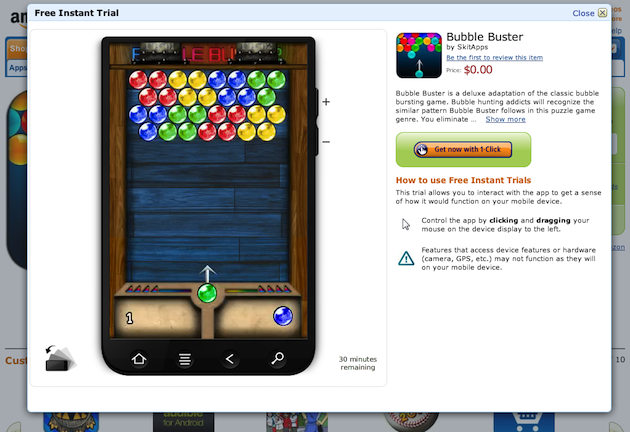 Amazon is shutting down TestDrive, one of the differentiating
features of the Amazon Appstore which allowed consumers to test out new
applications ahead of purchase. The feature was introduced back in March 2011 alongside
the launch of the Appstore itself, where it then utilized a
browser-based emulated instance of Android running in the cloud.
This let consumers control an application and experience it like they
would on their Android device. The feature later arrived on Android phones, too.
Amazon is shutting down TestDrive, one of the differentiating
features of the Amazon Appstore which allowed consumers to test out new
applications ahead of purchase. The feature was introduced back in March 2011 alongside
the launch of the Appstore itself, where it then utilized a
browser-based emulated instance of Android running in the cloud.
This let consumers control an application and experience it like they
would on their Android device. The feature later arrived on Android phones, too.Amazon says that the decision to close the service was based on “a significant decline” in usage, and cited the popularity of “free to play” business models as a factor.
Many of the apps that offered TestDrive were mobile games, as those are generally the kinds of apps that consumers wanted to check out ahead of making a purchase. But game publishers these days tend to generate revenue through sales of virtual goods and other in-app purchases – not by offering their app as a paid download. That means that consumers who wanted to experience a game could simply download it for free on their mobile device and play it. There was no need, really, to test it out first using another means.
 To date, 16,000 apps took advantage of the service, which never expanded outside the U.S., Amazon’s website notes.
That cited figure indicates there was little developer interest in
using TestDrive in recent years – it’s the same number that was
mentioned as the number of available TestDrive apps back in 2012.
To date, 16,000 apps took advantage of the service, which never expanded outside the U.S., Amazon’s website notes.
That cited figure indicates there was little developer interest in
using TestDrive in recent years – it’s the same number that was
mentioned as the number of available TestDrive apps back in 2012. Because the feature wasn’t universally adopted by developers, consumers would often find that the apps they’d like to “test drive” weren’t supported. Other times, consumers weren’t even aware that such an option existed.
TestDrive was an interesting and innovative feature for its time – and it helped Amazon’s new Appstore stand out from competitors like Google Play and iTunes.
But these days, the top app stores offer a variety of ways to experience and discover new apps, including the ability to watch videos alongside viewing app screenshots, for example. And even in the case of paid downloads, app publishers regularly run promotions to temporarily make their apps free, in order to attract new users. Amazon, too, runs similar promotions on behalf of app publishers. In fact, it’s doing so now – a sale launched this week is offering 26 applications, which would usually cost around $105.00, for free.
Plus, as TechCrunch recently discovered, Amazon is rolling out new ways to try apps which are just as innovative as TestDrive ever was – including Amazon “Unlocked,” a sort of Amazon Prime for apps that will give away paid apps for free as part of an upcoming service.